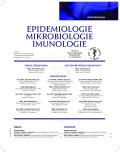Molecular-epidemiological characteristics and diversity of Listeria monocytogenes in the human population in the Czech Republic in 2013–2016
Authors:
T. Gelbíčová 1; Z. Tomáštíková 1,2; R. Karpíšková 1
Authors‘ workplace:
Výzkumný ústav veterinárního lékařství, v. v. i., Brno
1; Veterinární a farmaceutická univerzita, Brno
2
Published in:
Epidemiol. Mikrobiol. Imunol. 66, 2017, č. 3, s. 146-148
Category:
Short Communication
Overview
Listeria monocytogenes is the cause of a serious foodborne infection with a high fatality rate. The aim of this study was to assess the diversity of human isolates of L. monocytogenes recovered in the Czech Republic from 2013 to 2016 by molecular biological methods. Most cases of listeriosis were caused by strains of serotype 1/2a (58 %) from clonal complex CC8 (28 %) and serotype 4b (28 %) from CC6 (16 %). The results of macrorestriction analysis confirmed primarily the occurrence of sporadic cases of listeriosis. A local outbreak of listeriosis was reported in the Moravian-Silesian Region. Real-time molecular subtyping methods have proved helpful in the investigation of Listeria outbreaks.
KEYWORDS:
listeriosis – serotype – clonal complex – pulsotype – molecular epidemiology
Sources
1. EFSA (European Food Safety Authority) and ECDC (European Centre for Disease Prevention and Control) 2016. The European Union summary report on trends and sources of zoonoses, zoonotic agents and food-borne outbreaks in 2015. EFSA Journal, 2016;14(12): 231pp.
2. Lomonaco S, Nucera D, Filipello V. The evolution and epidemiology of Listeria monocytogenes in Europe and the United States. Infect Gen Evol, 2015;35 : 172–183.
3. Ruppitsch W, Pietzka A, Prior K, et al. Defining and evaluation a core genome multilocus sequence typing scheme for whole-genome sequence-based typing of Listeria monocytogenes. J Clin Microbiol, 2015;53(9): 2869–2876.
4. Chenal–Francisque V, Maury MM, Lavina M, et al. Clonogrouping, a rapid multiplex PCR method for identification of major clones of Listeria monocytogenes. J Clin Microbiol, 2015; 53(10): 3355–3358.
5. Doumith M, Buchrieser C, Glaser P, et al. Differentiation of the major Listeria monocytogenes serovars by multiplex PCR. J Clin Microbiol, 2004;42(8): 3819–3822.
6. Roussel S, Michelon D, Lombard B, et al. Molecular typing of Listeria monocytogenes strains isolated from food, feed and animals: state of play and standard operating procedures for pulsed field gel electrophoresis (PFGE) typing, profile interpretation and curation. EFSA supporting publication, 2014; EN-702, 81 pp. ISSN 2397-8325.
7. Jensen AK, Björkman JT, Ethelberg S, et al. Molecular typing and epidemiology of human listeriosis cases, Denmark, 2002–2012. Emerg Infect Dis, 2016;22(4): 625–633.
8. Knabel SJ, Reimer A, Verghese B, et al. Sequence typing confirm that a predominat Listeria monocytogenes clone caused human listeriosis cases and outbreaks in Canada from 1988 to 2010. J Clin Microbiol, 2012;50(5): 1748–1751.
9. Maury M, Tsai YH, Charlier C, et al. Uncovering Listeria monocytogenes hypervirulence by harnessing its biodiversity. Nat Genet, 2016;43(3): 308–313.
10. Gelbíčová T, Koláčková I, Pantůček R, et al. A novel mutation leading to a premature stop codon in inlA of Listeria monocytogenes isolated from neonatal listeriosis. New Microbiol, 2015;38(2): 293–296.
Labels
Hygiene and epidemiology Medical virology Clinical microbiologyArticle was published in
Epidemiology, Microbiology, Immunology

2017 Issue 3
Most read in this issue
- Hantavirus causing fatal haemorrhagic fever in the Czech Republic
- Possibilities for laboratory diagnosis of leptospiroses
- Serological diagnosis of whooping cough using immunoblot methods
- Legionellosis and its diagnosis
